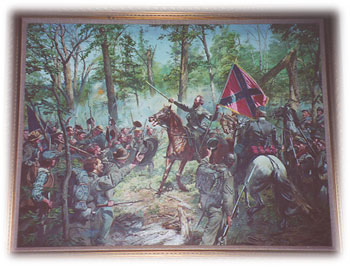

Battlefields
 Kelly's Ford
Kelly's Ford
At dawn on March 17, 1863, Brig. Gen. William W. Averell led 2,100 Union cavalrymen across the Rappahannock river here at Kelly's Ford. Brig. Gen. Fitzhugh Lee with about 1,000 Confederate horsemen counterattacked northwest of here about noon. Noted Confederate artillerist Maj. John Pelham accompanied Lee's men and fell mortally wounded while impetuously taking part in a charge. The battle ended in a draw, marking the first time Confederate cavalrymen had not defeated their Union opponents giving the Union cavalry confidence. It foreshadowed another Union crossing at Kelly's Ford during the much larger battle of June 9, 1863 at Brandy Station. Click map for larger image 
Brandy Station In the early morning of June 9, 1863, a large Union cavalry column under US Brigadier General John Buford positioned itself along the Rappahannock River for a peremptory rush across Beverly´s Ford. Buford´s horsemen, as well as a wing of equal strength headed by US Brigadier General David McMurtrie Gregg stationed six miles below at Kelly´s Ford, had arrived in Culpeper County, Virginia, looking for a fight. US Colonel Benjamin F. "Grimes" Davis´s New York Cavalry led the Union column thundering across the Ford, thus opening the battle of Brandy Station, the most hotly contested cavalry engagement of the Civil War. It was the largest single mounted battle ever fought in North America. Although at the end of the day Buford´s forces retreated back across Beverly´s Ford the Union Calvary had begun its rapid rise to power over the proud but dwindling Confederate Calvary. Cedar Mountain On August 9, 1862, the fabled CS Major General Thomas J. "Stonewall" Jackson came close to suffering a thorough trouncing at the hands of a much smaller Union Force. He salvaged an important victory by personally rallying his men under intense hostile fire. At the crisis of the fight at Cedar Mountain, Jackson waded into the melee waving his sheathed sword in one hand and a battle flag in the other while Union bullets flew past from three directions. His fleeing troops rallied at the sight of their fabled leader and won the battle. The famous painting by Don Troiani depicting this battle hangs in the library of the Main House. 
Rappahannock Station - Remington After the defeat at Bristoe Station, CS General Robert E. Lee retreated south of the Rappahannock River, with US General Meade in pursuit. Lee established a fortified bridgehead on the north bank of the river at Rappahannock Station. He planned to force the Federals to cross the river at Kelly´s Ford farther to the southeast and then counterattack as the federal army crossed. He concentrated his army near Kelly´s Ford, leaving Rappahannock Station protected only by the Louisiana Brigade under CS Brigadier General Harry T. Hays. The Army of the Potomac approached on November 7, 1863. CS Major General Jubal A. Early reinforced the bridgehead with CS Colonel Archibald C. Godwin´s Brigade. US Major General John Sedgwick´s VI Corps surrounded the bridgehead, with the V Corps in support. Sedgwick designated two VI corps brigades to lead the assault. After dark, the 2,100 Federals used a railroad embankment to conceal their movement up to the earthworks. In their surprise attack they overran the Confederates, taking 1,675 prisoners there and another 300 when US Major General William H. French´s III Corps stormed across Kelly´s Ford. Because of the Union success at Rappahannock Station and Kelly´s Ford, Lee abandoned his plan to winter in Culpeper County and retreated south of the Rappahannock River. Chancellorsville During the first week of May 1863, General Robert E. Lee and C. S. Lieutenant General "Stonewall" Jackson led a dramatically outnumbered Army of Northern Virginia to victory in the battle of Chancellorsville. That battle has been aptly called Lee´s greatest victory and was one of the Confederacy´s brightest moments. The Battle of Chancellorsville gave the Army of North Virginia momentum that Lee turned into an aggressive campaign a few weeks later that led to Gettysburg. This 2,600-acre Battlefield is a unit of Fredericksburg and Spotsylvania National Military Park. Wilderness Though they made few efforts to memorialize it after the war, the soldiers who fought there never forget the Wilderness. The region which was known as the Wilderness long before the Civil War, lay ten miles west of Fredericksburg, a patch of natural entanglement some twelve miles wide and six miles deep along the south bank of the Rapidan River. For Union planners the Wilderness was something to be crossed with the least possible delay. For CS General Robert E. Lee, Wilderness was an ally that would negate the Union´s numerical advantage. The Federal movement was one part of US Lieutenant General Ulysses S. Grant´s grand strategy to squeeze the pressure points of the Confederacy. Simultaneously with this move, other Union forces were advancing aggressively against Atlanta and Petersburg and into the Shenandoah Valley. The Union Army entered the Wilderness in two columns totaling 115,000 men to meet Lee´s 60,000-man army. In the May 5-6 fighting in the Wilderness nearly the full force of both armies was engaged. Union casualties tallied nearly 18,000 and the Confederate toll was estimated at 10,800. To the claustrophobic nature of the combat was added the terror of numerous flash fires that raged through the dry underbrush, incinerating soldiers too badly wounded to escape. A Northern private wrote that "it was a blind and bloody hunt to the death, in bewildering thickets, rather than a battle." A Southern officer declared, "I do not think I have ever seen a battlefield where there was more destruction and more horrors than that of the Wilderness." Despite his heavy losses, Grant ordered the Army of the Potomac to continue its campaign by sliding past Lee´s flank and moving south. For the first time in his Civil War experience, Robert E. Lee faced an adversary who had the determination to press on despite the cost. Grant´s overland campaign moved along to other bloody battlefields, ending in the slow strangulation of Lee´s army at Petersburg. The moment of truth came in the Wilderness. Once Grant decided to move forward and not retreat, it was just a question of time. The battle of the Wilderness marked the beginning of the end for the Army of Northern Virginia and for the Confederacy itself. The Wilderness Battlefield, a unit of Fredericksburg and Spotsylvania National Military Park, is near Route 3, west of Fredericksburg. There are 3,305 acres of the historic battlefield in this unit. Fredericksburg On December 12, 1862 the Army of the Potomac crossed the Rappahannock on masse and looted Fredericksburg in a shameful display of vandalism. On December 13, U.S. General Meade covered by a fog moved west toward Hamilton´s Crossing. Suddenly Confederate artillery erupted behind the Union Forces halting them in their tracks. The guns belonged to a 24 year old Alabamian, CS Major John Pelham, Commander CS Major General James Stuart´s Confederate horse artillery. The young officer had recklessly advanced two pieces directly on Meade´s flank and rear and boldly maintained his position, despite losing the use of one gun early in the action. Pelham defied orders to retreat and returned to his lines only after he had exhausted his ammunition. Pelham´s heroics not only delayed the Union advance but also induced Meade´s supports on the left to remain east of the Richmond Stage Road. Lee brilliantly crafted his defense so that artillery swept the open ground to which Meade´s was advancing. "A chicken could not live on that field when we opened on it" boasted the Confederate cannoneer. Wave after wave of Union troops staggered through the fire of massed artillery only to encounter a shot of flame from the infantry 150 yards away behind a stone wall. When the firing ended, not one Union soldier had laid a hand on the stone wall. The battle of Fredericksburg cost the Union 12,000 casualties, an overwhelming victory for the Army of Northern Virginia. Manassas The second Battle of Manassas in August of 1862 brought Robert E. Lee, "Stonewall" Jackson and the Confederacy to the height of their power and opened the way for Lee´s first invasion of the North. But their victory came with horrid losses to both sides. A total of 3,300 dead and 15,000 wounded. Manassas National Battlefield Park includes 5,072 acres of this Historic Battlefield. Back to Information |
||||

| ||||